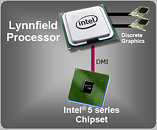Sunday, April 26th 2009

Core i5 to Feature Lower QPI Multiplier
Intel's newest line of CPUs, the Core i5 series is generating quite some buzz ahead of its release, with each piece of detail emerging about the processors adding to the attention it's gathering. Expreview has learned that the Core i5 series processors will feature a slightly different system interface in comparison to their Core i7 cousins.
Coming to the QPI interface between the CPU and NB dice, Intel will raise the QPI base frequency at the expense of lowering the multiplier. For example, the Core i7 uses a 20+ multiplier with a base frequency of 133 MHz. This frequency could be scaled up to 166 MHz at 24x multiplier due to the theoretical speed-limit of QPI at 8.00 GT/s. With the Core i5, Intel will set lower QPI multiplier values (around 16X), while upping the base frequency to around 250 MHz.
Source:
Expreview
Coming to the QPI interface between the CPU and NB dice, Intel will raise the QPI base frequency at the expense of lowering the multiplier. For example, the Core i7 uses a 20+ multiplier with a base frequency of 133 MHz. This frequency could be scaled up to 166 MHz at 24x multiplier due to the theoretical speed-limit of QPI at 8.00 GT/s. With the Core i5, Intel will set lower QPI multiplier values (around 16X), while upping the base frequency to around 250 MHz.

25 Comments on Core i5 to Feature Lower QPI Multiplier
Also:
There is a theory as to where exactly Intel will place the memory controller. I'm waiting for some confirmation. It says that on some models (that lack an IGP), the CPU die will hold a dual-DDR3 IMC (same basic design as the i7 die), while those chips with IGPs will have the CPU die without any IMC, the northbridge die will hold the memory controller and the IGP.
So far we know that Clarkdale (Core i5 dual-core) has a 32nm CPU die, and a 45nm NB die, while Lynnfield (Core i5 quad-core) has both CPU and NB dice built on the 45 nm process.
Need more sources on the IMC part.
In dumbass terms, how fast is it in refrence to C2D/Q & i7
i mean for an i5 to work they need to have a northbridge with igp and memory controller off the cpu, but that means that having them on the cpu is pointless as then there would be 2
OH FUCK dont tell me they are going to bring out boards with no igp and memory controller on the northbridge and some with, that sucks meaning that if you choose to get a new cpu and yours has no memory controller onboard you need to get a cpu with one on it, cant choose the other type of cpu coz then there would be no memory controller
what is the point of this just make all cpus one way and all boards one way not have one with a controller one without
250MHz x 16 (as given in the article) is 4GHz.
Since the i5s are meant to be lower frequencies than i7 (there was mention of circa 2.5GHz or so) then the multiplier for a 2.5GHz would be 10x.
Lynnfield will have the IMC on the CPU die (there is only 1 die for Lynnfield).
Clarkdale will have the IMC on the IGP die and not on the CPU die. Nevertheless, this will not affect which motherboard you have to get. Clarkdale's IMC is rumoured to not be the same as Lynnfield's - it is apparently going to be based on the current G45's MC. Whereas the Lynnfield IMC will be based on the i7 one.
The higher clockspeed and integrating the northbridge on the processor are both cost cutting strategies. We'll see how that translates to wholesale and platform prices though. Maybe, just maybe, the platform price will be down by about 20-30% because of these changes (instead of $200, it might cost $140, for example).
Capiche?
The most likely explanation for Clarkdale's design approach is because the IGP needs memory, and the best way to have some, is by having a memory controller next to you.
Somehow this all makes me think they are OC monsters and they need to have a low multi or no-one would get a i7. With 133MHx they do instant 4,5GHz upping the "FSB" to now stock 250MHz :p
Anyways they should get them out already and not just leak info every month to get free advertising. With all this "hype" they'll flop having nothing short of near i7 performance.
That is, the IGP makes requests to the IMC the same way the cores do (via QPI). QPI is literally a computer on a single chip (all MCM like). Lemme try to map out what makes sense to me...
Bloomfield|Type A|Off-Die|N/A
Lynnfield|Type B|MCM|N/A?
Clarkdale|Type B|MCM|MCM
Type A = High IPC, Tri-Channel memory controller.
Type B = Low IPC, Dual-Channel memory controller.
MCM = Multi-Chip Module (not integrated in to the core but integrated under the IHS)
? = Not sure if the door is left open to a third party (like VIA) to make a IGP or not.
There's no reason to believe the actual processor cores in Lynnfield/Clarkdale are different in any way just as a Core 2 Duo hooked up to a G43 or a P45 makes no difference to the processor. Likewise, how a AMD 6000+ hooked into an 790GX vs a 790 FX makes no difference to the processor. To the processor, it is no different than having a 4870 in a PCI Express slot--just something else to nag it for data.
Think of QPI is an FSB that is point-to-point instead of shared. That makes the processor a mini motherboard. ;)
Hmm, don't think I can add anymore than that. XD
QPI is between the cores, IMC, and northbridge.